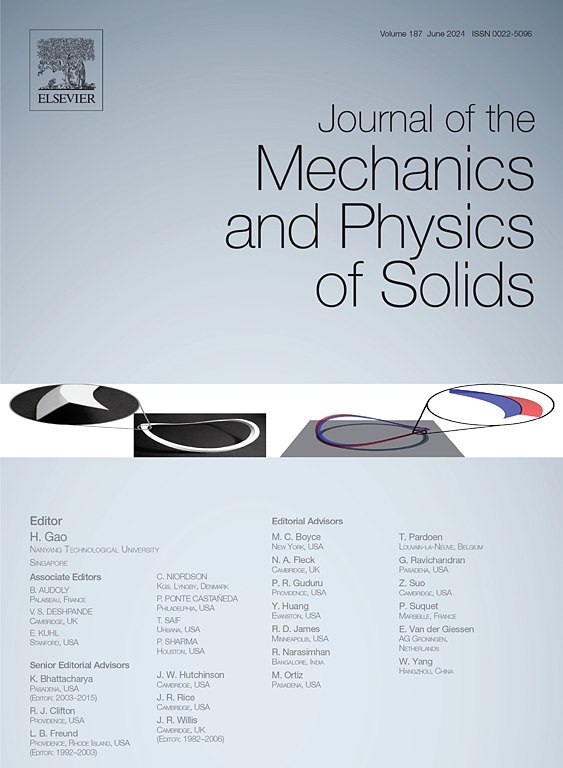固态电池中锂金属间界面形态发生的连续计算研究
IF 5
2区 工程技术
Q2 MATERIALS SCIENCE, MULTIDISCIPLINARY
引用次数: 0
摘要
与液体电解质系统相比,锂阳极固态电池的设计具有高容量和提高安全性的前景,因此备受关注。锂作为电流载体的输运性质导致了每一次充放电循环中阳极的吸积或剥离。虽然这带来了从突起(树突)的生长到失去接触的挑战,但其中潜藏着一个机会:可以研究阳极-电解质界面层的形态发生,并可能最终作为固态电池设计的一个因素加以控制。如果在阳极中引入锂合金,则可访问的界面形态,其动态路径和控制机制将大大扩展。锂金属间化合物的热力学和动力学为形成界面的设计提供了原则性的方法。在这次交流中,我们采用计算方法来进行这样的探索。利用第一性原理原子计算和实验相结合的参数化相场模型,我们对两种锂金属间化合物:Li-Mg和Li-Zn进行了现象学研究。对动力学、充放电速率、循环、输运机制和晶粒结构的影响进行了一系列参数研究。这些计算的重点是金属间界面的动态形态发生。具体而言,研究了Li、Mg和Zn的电镀、偏析和均匀分布、空隙的生长和消失、固体电解质-阳极接触面积的演变以及晶界结构。计算平台是未来研究形态形成的电解质-阳极界面的框架,具有更广泛的第一性原理原子学和实验输入。本文章由计算机程序翻译,如有差异,请以英文原文为准。
A continuum, computational study of morphogenesis in lithium intermetallic interfaces in solid state batteries
The design of solid state batteries with lithium anodes is attracting attention for the prospect of high capacity and improved safety over liquid electrolyte systems. The nature of transport with lithium as the current carrier has as a consequence the accretion or stripping away of the anode with every charge–discharge cycle. While this poses challenges from the growth of protrusions (dendrites) to loss of contact, there lurks an opportunity: Morphogenesis at the anode–electrolyte interface layer can be studied, and may ultimately be controlled as a factor in solid state battery design. The accessible interface morphologies, the dynamic paths to them, and mechanisms to control them expand considerably if lithium alloys are introduced in the anode. The thermodynamics and kinetics of lithium intermetallics present principled approaches for morphogenic interface design. In this communication we adopt a computational approach to such an exploration. With phase field models that are parameterized by a combination of first principles atomistic calculations and experiments, we present phenomenological studies of two lithium intermetallics: Li–Mg and Li–Zn. An array of parametric investigations follows on the influence of kinetics, charge–discharge rate, cycling, transport mechanisms and grain structure. The emphasis across these computations is on the dynamic morphogenesis of the intermetallic interface. Specifically, the plating, segregation and smooth distribution of Li, Mg and Zn, the growth and disappearance of voids, evolution of solid electrolyte–anode contact area, and grain boundary structure are investigated. The computational platform is a framework for future studies of morphogenic electrolyte–anode interfaces with more extensive inputs from first principles atomistics and experiments.
求助全文
通过发布文献求助,成功后即可免费获取论文全文。
去求助
来源期刊
CiteScore
9.80
自引率
9.40%
发文量
276
审稿时长
52 days
期刊介绍:
The aim of Journal of The Mechanics and Physics of Solids is to publish research of the highest quality and of lasting significance on the mechanics of solids. The scope is broad, from fundamental concepts in mechanics to the analysis of novel phenomena and applications. Solids are interpreted broadly to include both hard and soft materials as well as natural and synthetic structures. The approach can be theoretical, experimental or computational.This research activity sits within engineering science and the allied areas of applied mathematics, materials science, bio-mechanics, applied physics, and geophysics.
The Journal was founded in 1952 by Rodney Hill, who was its Editor-in-Chief until 1968. The topics of interest to the Journal evolve with developments in the subject but its basic ethos remains the same: to publish research of the highest quality relating to the mechanics of solids. Thus, emphasis is placed on the development of fundamental concepts of mechanics and novel applications of these concepts based on theoretical, experimental or computational approaches, drawing upon the various branches of engineering science and the allied areas within applied mathematics, materials science, structural engineering, applied physics, and geophysics.
The main purpose of the Journal is to foster scientific understanding of the processes of deformation and mechanical failure of all solid materials, both technological and natural, and the connections between these processes and their underlying physical mechanisms. In this sense, the content of the Journal should reflect the current state of the discipline in analysis, experimental observation, and numerical simulation. In the interest of achieving this goal, authors are encouraged to consider the significance of their contributions for the field of mechanics and the implications of their results, in addition to describing the details of their work.

 求助内容:
求助内容: 应助结果提醒方式:
应助结果提醒方式:


